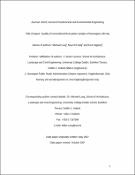Options
Quality of conventional fixed piston samples of Norwegian soft clay
Date Issued
2009-02
Date Available
2011-08-10T10:24:23Z
Abstract
It is well accepted that the quality of soft clay samples obtained using standard
fixed piston samplers can be relatively poor and that block samples are necessary to
yield very high quality samples. However for many practical projects it is not
economically viable or physically practical to obtain block samples. In this project the
quality of standard 54 mm composite piston samples of soft clay is examined by
comparing six separate sets of 54 mm samples to parallel block sampling. Sampling
and laboratory testing was carried out by three different organisations at a well
characterised highly uniform soft clay site in Norway. As expected the work showed
that the block samples behaved significantly differently from those obtained using the
54 mm sampler and were of higher quality. Block sample derived parameters were
considerably different from those obtained from the 54 mm sample tests. However
significant differences were also found between the different sets of 54 mm samples.
Although the differences are less than when compared with block samples, the
consequences of poor quality 54 mm sampling will be significant in engineering
design. It is concluded that the differences are due to small details in the sampling
operation such as the need to keep the piston effectively stationary at all times, to
avoid overcoring and to handle the recovered sample carefully. If a well trained driller
follows good quality practice, then relatively good samples can be obtained by the fixed piston sampler, which are suitable for analysis and design of routine engineering
works.
fixed piston samplers can be relatively poor and that block samples are necessary to
yield very high quality samples. However for many practical projects it is not
economically viable or physically practical to obtain block samples. In this project the
quality of standard 54 mm composite piston samples of soft clay is examined by
comparing six separate sets of 54 mm samples to parallel block sampling. Sampling
and laboratory testing was carried out by three different organisations at a well
characterised highly uniform soft clay site in Norway. As expected the work showed
that the block samples behaved significantly differently from those obtained using the
54 mm sampler and were of higher quality. Block sample derived parameters were
considerably different from those obtained from the 54 mm sample tests. However
significant differences were also found between the different sets of 54 mm samples.
Although the differences are less than when compared with block samples, the
consequences of poor quality 54 mm sampling will be significant in engineering
design. It is concluded that the differences are due to small details in the sampling
operation such as the need to keep the piston effectively stationary at all times, to
avoid overcoring and to handle the recovered sample carefully. If a well trained driller
follows good quality practice, then relatively good samples can be obtained by the fixed piston sampler, which are suitable for analysis and design of routine engineering
works.
Sponsorship
Not applicable
Type of Material
Journal Article
Publisher
ASCE
Journal
ASCE Journal of Geotechnical and Geoenvironmental Engineering
Volume
135
Issue
2
Start Page
185
End Page
198
Copyright (Published Version)
2009 ASCE
Subject – LCSH
Soils--Sampling--Norway
Soils--Testing
Clay--Testing
Language
English
Status of Item
Peer reviewed
ISSN
1090-0241 (print)
1943-5606 (online)
This item is made available under a Creative Commons License
File(s)
Loading...
Name
RVIIFinal.pdf
Size
381.94 KB
Format
Adobe PDF
Checksum (MD5)
a38c9f8c0d24ea37cf74430131dd3619
Owning collection